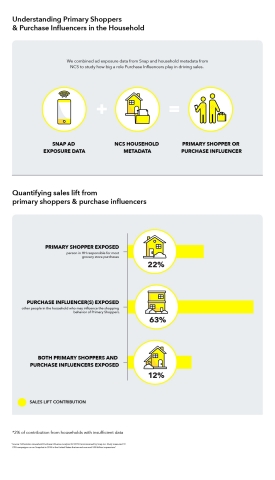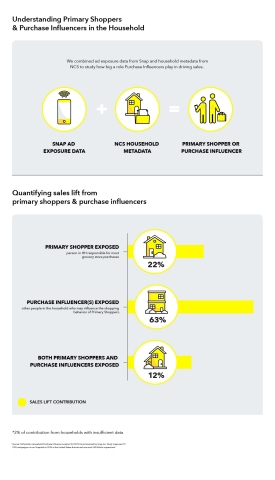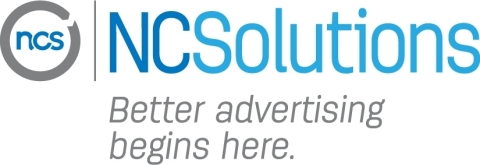NEW YORK--(BUSINESS WIRE)--Move over celebrities and micro-influencers: The youngest consumers among us just might be the hottest new influencers in town. NCSolutions, the leading company for improving advertising effectiveness for the entire CPG ecosystem, announced results today from an innovative meta-study in partnership with Snap Inc., creator of Snapchat. Based on the measurement of 19 CPG Snapchat advertising campaigns across 32 brands and almost 4 billion impressions, the study found 63 percent of sales driven by Snapchat advertisements were a result of ads that only reached household influencers, not the primary household purchasers.
This proof point in the new study demonstrates the influence of Gen Z. While this group may not purchase on behalf of the whole household, they do hold highly impactful purchase influence on household brands and products. A long-standing truism in CPG is that focusing media on a household’s primary shopper is the more effective and efficient method of driving short-term ROI for a brand. Yet brands today recognize that to maximize sales per household, they also need to reach and motivate influential younger consumers where they are – targeting them in new channels and with new tactics.
“Today Snapchat reaches 90% of all 13-24 year-olds and 75% of all 13-34 year-olds in the U.S. The industry has known for some time that Gen Z consumers influence household purchases, but until now we did not understand the high degree to which reaching them positively impacts brand sales,” commented John Eckhardt, Group Lead, Marketing Science, for Snapchat. “This is the first quantitative research to show Gen Z’s influence on CPG purchasing as a direct result of being exposed to ads, further reinforcing our belief that this generation represents a powerful long- and short-term sales growth driver for CPG brands.”
The study shows that even when Gen Zs – as non-purchasers – were the only household members to see a Snapchat ad, they still drove a significant increase in CPG purchase through their household influence. The sales lift was even greater when brands in the study reached both the household purchaser and the younger influencer. Brands were 100 percent more likely to experience over-indexing sales lifts1 when both the household purchaser and influencer saw the ad than when only the primary purchaser saw the ad.
This exceeds the general performance of Snapchat ads, shown to drive 17% higher return on investment than the mobile norm, according to NCSolutions (2.92 ROAS vs 2.50 ROAS from April 2016 through March 2019), indicating that much of this lift is due to household influence effects.
“For CPGs companies, efficient spending is imperative. Purchased-based targets help you reach buyers, but to drive sales you must also understand who they are, and how they are influenced. The results of this study emphasize the need for CPG brands to consider creative for Gen Z and of course for brands to have creative options that fit and make use of a platform like Snapchat, where their ads can reach that crucial Gen Z audience,” said Leslie Wood, Chief Research Officer, NCSolutions. “Even though these younger consumers don’t yet hold the finances, they do hold the power to sway household buying – that is the ultimate influencer.”
“The youngest generation has been influencing their parents’ household purchases for a long time. The difference is that today, there are more channels and methods than ever before to reach shoppers and influencers,” said Lance Brothers, Chief Revenue Officer, NCSolutions. “Advertisers have even more ways to grab the attention of and build lifelong loyalty with the youngest generation. This new study concretely demonstrates the value that social mobile and digital channels like Snapchat are not just key for winning over the hearts of Gen Zers, but also for influencing the wallets of their parents, and – ultimately – impacting sales lift.”
Advertising spend is most efficient when marketers can identify which consumer groups the messaging resonates with most, as shown by NCS’ recent industry research How to Build Brands. To learn more about NCS and its insights about How Advertising Works, visit our website.
John Eckhardt, Group Lead, Marketing Science at Snapchat will be presenting these results at Advertising Week New York on Wednesday, September 25, at 12:45 pm.
ABOUT the STUDY
NCSolutions (NCS) ran a meta-analysis study of 19 Snapchat advertising campaigns with 32 total brand reads. Using ad exposure and demographic data to determine the shopping responsibilities of those who saw the ad, households were placed into one of the following three categories and sales lift metrics were aggregated across these dimensions:
- Primary Shopper: the person in the household most responsible for grocery store purchases saw a product campaign ad on Snapchat
- Purchase Influencer(s): those in the household who may influence the behavior of the household’s Primary Shopper, but are not themselves responsible for purchasing, saw a product campaign ad on Snapchat
- Both Primary Shoppers and Purchase Influencers: households in which both the Primary Shopper and Purchase Influencer(s) were exposed to a product campaign ad on Snapchat
ABOUT NCS
NCSolutions (NCS) makes advertising work better. Our unrivaled data resources powered by leading providers combine with scientific rigor and leading-edge technology to empower the CPG ecosystem to create and deliver more effective advertising. With NCS’s proven approach, brands are achieving continuous optimization everywhere ads appear, through purchase-based audience targeting and sales measurement solutions that have impacted over $25 billion in media spend for our customers. Visit us at ncsolutions.com to learn more.
ABOUT SNAP INC.
Snap Inc. is a camera company. We believe that reinventing the camera represents our greatest opportunity to improve the way people live and communicate. We contribute to human progress by empowering people to express themselves, live in the moment, learn about the world, and have fun together. For more information, visit snap.com.
1 Response index = (% contribution to sales lift / % exposed households) * 100; Over-indexing response index >= 115




